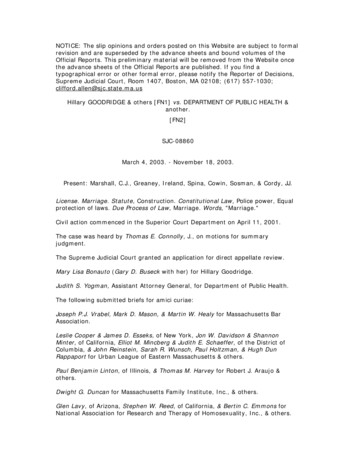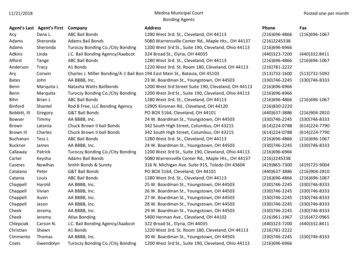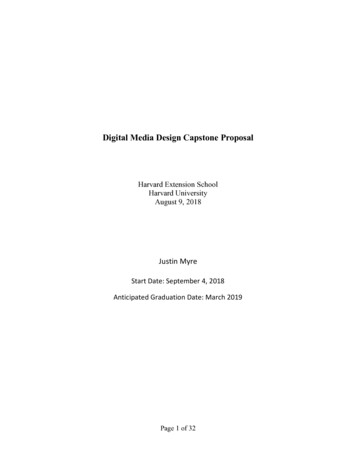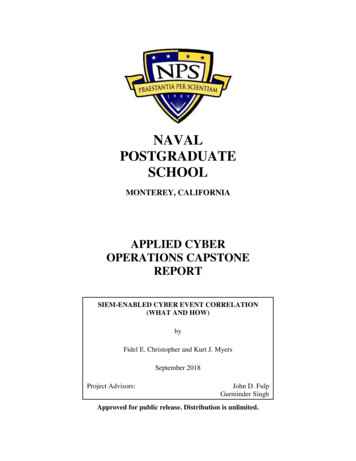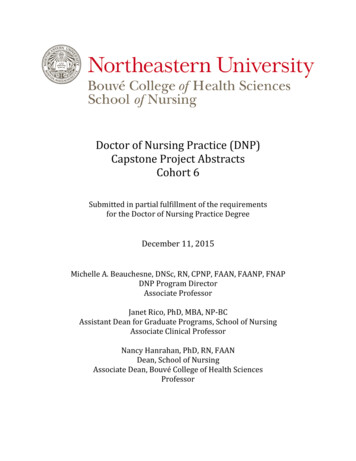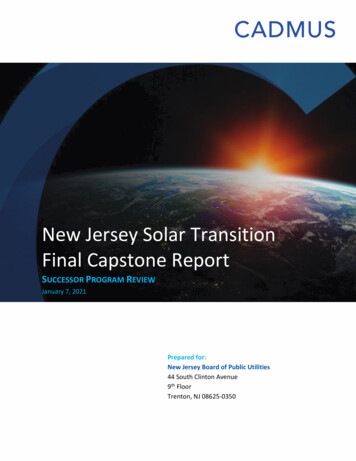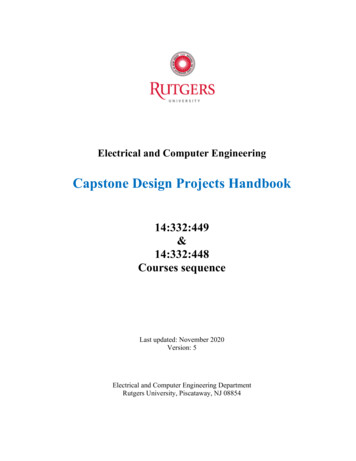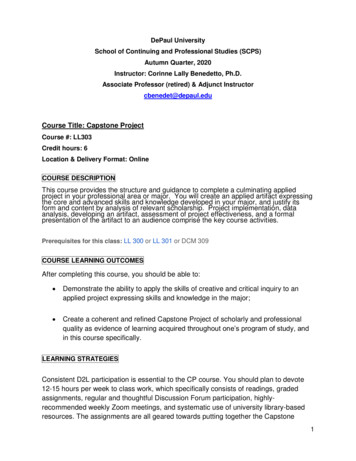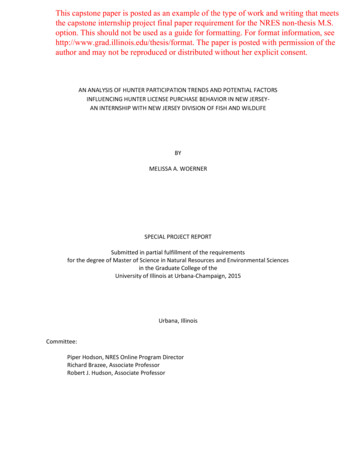
Transcription
This capstone paper is posted as an example of the type of work and writing that meetsthe capstone internship project final paper requirement for the NRES non-thesis M.S.option. This should not be used as a guide for formatting. For format information, seehttp://www.grad.illinois.edu/thesis/format. The paper is posted with permission of theauthor and may not be reproduced or distributed without her explicit consent.AN ANALYSIS OF HUNTER PARTICIPATION TRENDS AND POTENTIAL FACTORSINFLUENCING HUNTER LICENSE PURCHASE BEHAVIOR IN NEW JERSEYAN INTERNSHIP WITH NEW JERSEY DIVISION OF FISH AND WILDLIFEBYMELISSA A. WOERNERSPECIAL PROJECT REPORTSubmitted in partial fulfillment of the requirementsfor the degree of Master of Science in Natural Resources and Environmental Sciencesin the Graduate College of theUniversity of Illinois at Urbana-Champaign, 2015Urbana, IllinoisCommittee:Piper Hodson, NRES Online Program DirectorRichard Brazee, Associate ProfessorRobert J. Hudson, Associate Professor
ABSTRACTThe vast majority of funds for fish and wildlife management and habitat enrichment have beenfrom the sale of hunting and fishing licenses and from excise taxes on hunting and fishing equipment.However, several studies have documented that hunting participation has been declining in the UnitedStates, potentially creating revenue shortfalls that impact both hunting and non-hunting conservationinitiatives. State agencies are responsible for managing the harvest and hunting seasons for most gamespecies and are therefore largely responsible for managing hunter participation, recruitment, andretention. This paper details the results of an internship with New Jersey Division of Fish and Wildlifethat aimed to identify trends in hunter recruitment, retention, and license purchase behavior to helpguide efforts to increase hunter participation in the state. The internship project was modeled after arecent national study involving twelve state wildlife agencies, with the addition of a GIS component andstatistical analysis. Results indicate significant hunter retention issues in New Jersey and identifysegments of the hunting population that would have the most significant impact on license sales.ii
ACKNOWLEDGMENTSThis project would not have been possible without the support of many people. I would like tothank my advisor, Piper Hodson, for her guidance throughout my graduate tenure, as well as ReneeGracon for her patience, encouragement, and committed assistance during my capstone internshipexperience. I would also like to thank Dr. Tim Ellsworth for his constructive recommendations duringthe preliminary stages of this project. I also wish to thank Tianyu Wang, Zhaoying (April) Tang, andQianyu Cheng from University of Illinois’ Statistics in the Community for their technical assistance withstatistical analysis and modeling.I would like to thank several current and former employees of New Jersey Division of Fish andWildlife for contributing their knowledge and skills to this project. For initially suggesting a capstoneinternship idea that would both satisfy the degree requirements and contribute valuable information toNew Jersey Division of Fish and Wildlife, I owe thanks to Jim Sciascia and Paul Ritter. For their help withobtaining and processing data, I would like to thank Bob Longcor and Barb Stoff. For his invaluableassistance organizing and analyzing data in Microsoft Access, I would like to thank Pete Winkler.I also owe thanks to my husband and co-worker, Patrick Woerner, for his GIS guidance on thisproject, but especially for always offering love and support while enduring this long process with me.Finally, I wish to thank my parents for their endless encouragement and my daughter, Sarah Woerner,who was born in the midst of my graduate career and always brought a smile to my face when I neededit most.iii
LIST OF ACRONYMS AND ABBREVIATIONSALSAutomated Licensing SystemCIDCustomer Identification numberGISGeographic Information SystemGLMGeneralized Linear ModelLULCLand Use/Land CoverM.S.Master of ScienceNJDFWNew Jersey Division of Fish and WildlifeNRESNatural Resources and Environmental SciencesStatComStatistics in the CommunityUIUCUniversity of Illinois at Urbana-Champaigniv
TABLE OF CONTENTSCHAPTER 1: INTRODUCTION 1CHAPTER 2: METHODS .7CHAPTER 3: RESULTS 16CHAPTER 4: DISCUSSION 25CHAPTER 5: RECOMMENDATIONS .29CHAPTER 6: INTERNSHIP EVALUATION 30REFERENCES 33APPENDIX A: FIGURES AND TABLES 35APPENDIX B: STATISTICAL MODELS . 68v
CHAPTER 1: INTRODUCTION1.1 Internship experience and learning objectivesFrom March of 2014 to July of 2015, the author completed a capstone internship experiencewith the New Jersey Department of Environmental Protection’s Division of Fish and Wildlife (NJDFW).The internship was carried out in conjunction with the author’s current employment as a SeniorBiologist within the Information and Education Bureau’s Hunter Education Unit under the supervision ofPaul Ritter. The internship accounted for 180 hours with hours per week varying dependent on otherwork responsibilities. Work was completed in the Central Region Office in Upper Freehold Township,New Jersey. NJDFW is a state-government “environmental agency dedicated to the protection,management and wise use of New Jersey's fish and wildlife resources” (NJDFW 2015a).For the capstone internship experience, the author researched the gap between huntereducation graduates and hunting license sales. Although every prospective hunter in New Jersey isrequired to complete a hunter education course, not every graduate goes on to buy a hunting license.The aim of the capstone was to identify where intervention efforts may be helpful to increase huntingparticipation and retention rates among new hunters in New Jersey. Learning objectives includedresearching the role of hunting and license sales in wildlife and natural resource management,identifying trends in license purchase behavior among different segments of the population, andexploring potential factors that may influence hunter recruitment and retention. Hours dedicated tocompleting the learning objectives were spent conducting literature reviews and gathering backgroundinformation; obtaining and processing data; analyzing data using Microsoft Access, ArcGIS, andstatistical modeling; collaborating with NJDFW employees; and preparing periodic reports and the finalcapstone internship paper.1.2 Literature ReviewHunting is a primary means of wildlife management (Carpenter 2000; Riley et al. 2003) and hascontributed greatly to the advancement of scientific knowledge and research techniques. For example,recovered bands from harvested waterfowl allowed scientists to estimate North American waterfowlpopulations and led to the mark-recapture method known as the Lincoln-Peterson index (Lincoln 1930;White and Bishop 2010). Game harvest and subsequent manipulation of game populations facilitatedthe development of survival estimation methods that have been extended to apply to nongame species(Brownie et al. 1978), the effects of density dependence on population regulation (McCullough 1979),1
and adaptive harvest management (White and Bishop 2010). Hunting is a means of balancing predatorprey relationships (White and Bishop 2010) and controlling overabundant populations that can lead toecologic and economic damage (Kilpatrick and Walter 1999; Conover 2001; Côté et al. 2004).Furthermore, the vast majority of funds for fish and wildlife management and habitat enrichment havebeen from the sale of hunting and fishing licenses and from excise taxes on hunting and fishingequipment (Mangun and Shaw 1984; Peterson 2004; White and Bishop 2010; Williams 2010).In New Jersey, 116 million was spent on hunting expenditures in the year 2011 (United StatesDepartment of the Interior 2013). New Jersey specifically manages more than 354,000 acres of stateowned public open space to enhance wildlife populations and provide for wildlife-oriented recreationopportunities such as hunting (NJDFW 2015b). In addition, New Jersey provides year-round huntingopportunities, including seasons for small game, waterfowl, turkey, fox, coyote, white-tailed deer, andblack bear. However, hunter participation in New Jersey is primarily focused on white-tailed deer, with95% of the state’s hunters participating in deer hunting (United States Department of the Interior 2013).Hunting provides the primary means of controlling deer population sizes in the state, with 2014’s annualharvest totaling 52,704 deer (NJDFW 2015c). In 2014, hunting license and permit revenue generated 8.2 million and provided approximately 53% of the total wildlife conservation revenue for the state(NJDFW, Robert Longcor, personal communication, August 4, 2015). Because these funds can be usedfor the general administration of the state fish and wildlife agency, they can be spent on both huntingand non-hunting related programs.Several studies have documented that hunting rates have been declining in the United States(Enck et al. 2000; Shultz et al. 2003; Zinn 2003). Between 2001 and 2011, New Jersey showed a 30%decline in hunters (United States Department of the Interior 2013). State agencies, such as NJDFW, areresponsible for managing the harvest and hunting seasons for most game species. As such, they also arelargely responsible for managing hunter participation, recruitment, and retention. It is therefore criticalthat state-specific trends are identified in order for states to develop strategies to maximize hunterparticipation in their jurisdictions (Gude et al. 2012).Recently, the National Shooting Sports Foundation funded a national study on hunter educationgraduates’ proclivity to purchase a license (Southwick Associates 2013). The Southwick Associates(2013) study analyzed hunter education and license sales data from twelve state wildlife agenciesthroughout the country (Montana, Nevada, Utah, Washington, Michigan, Missouri, Nebraska, Georgia,Kentucky, Virginia, Maine, and Vermont), profiling the hunter education class of 2006 and theirsubsequent license buying habitats over the next six years (2006-2011). By cross-referencing each2
hunter education graduate’s record in the graduate database to records in each state’s license salesdatabase, trends could be developed. The results were “intended to help the hunting communityunderstand if and where intervention efforts may be needed to maintain hunting participation amongnewer hunters” (Southwick Associates 2013, p. iii). Their results showed that across the twelve statesanalyzed, an average of 67.7% of hunter education graduates purchased at least one hunting licensefrom 2006 to 2011, indicating that a significant portion of graduates did not buy a license aftergraduating. In addition, the number of graduates who bought a license from 2006 to 2011 decreased by34.5%; only 44% of graduates bought a license after six years (Southwick Associates 2013).In addition to identifying the percentage of graduates who purchased a license within six years,the Southwick Associates (2013) study analyzed other factors that may contribute to license purchasingbehavior. Their results across the twelve states showed that individuals who graduated from a huntereducation class in June and the warmer months comprised the greatest percentage of graduates whonever purchased a license (Southwick Associates 2013). This indicates that the seasonality of huntereducation classes could affect license purchasing behavior and that future retention efforts may benefitfrom minimizing classes in the summer months. They also found that in most states, graduates betweenthe ages of 16-24 were less likely to buy a license six years after graduating. In addition, collegestudents and those enlisted in the military were more likely to stop renewing their license within sixyears of graduating. They also found that graduates from highly urbanized areas showed the greatestdrop-out rates (Southwick Associates 2013). These results could help direct future retention efforts bytargeting specific groups of graduates that are at greatest risk for dropping out of the system. Inaddition to analyzing common trends across the study states, the Southwick Associates (2013) reportprovided individual state data to help each state agency maximize hunter participation rates in thefuture.In addition to the Southwick Associates (2013) study, there are several other studies that haveexplored trends in hunting license sales. Gude et al. (2012) also tracked hunter education graduates’license purchase behavior over a six-year period to estimate hunter recruitment, participation, andlicense purchasing probabilities in Montana. Using matrix population models, Gude et al. (2012) foundthat males had greater recruitment rates, retention rates, and license purchasing probabilities thanfemales; the young adult age class (19-30 year olds) had the lowest purchasing probability; and thattrends in license sales in Montana were most influenced by middle-aged (31-42 year olds) and babyboomer (43-59 year olds) male license purchase probabilities. Their results suggested that license sales3
and hunter participation in Montana could be most greatly influenced by programs focused onincreasing recruitment and retention in older age class males.Several other studies of hunter participation, recruitment, or retention have also madecomparisons among age classes (Mehmood et al. 2003; Zinn 2003; United States Department of theInterior 2013). However, there is little consistency in the categorization of age classes among studies,ranging from age classes corresponding to traditional life stages to classes divided into roughly equalsegments of years. While categorizing age into segments of roughly equal years (for example, 18-30, 3140, 41-50, 51-60, over 60) could facilitate more direct comparisons between classes, that methodologymay not accurately represent the lifestyles and behaviors characteristically associated with various lifestages. Since the author’s internship aimed to identify behavior differences among hunter educationgraduates, it was important to account for important behaviors that could influence huntingparticipation, such as leaving home for education or military pursuits, establishing careers and families,or retiring, when selecting age classes for analysis.There are several other demographic factors that have been analyzed in studies of hunterparticipation and retention, including ethnicity (Mehmood et al. 2003; Zinn 2003; United StatesDepartment of the Interior 2013), income (Mehmood et al. 2003; United States Department of theInterior 2013), education (Zinn 2003; United States Department of the Interior 2013), and urbanization(Zinn 2003; Southwick Associates 2013; United States Department of the Interior 2013). The author’sresearch was limited by the available information associated with each hunter education graduate (age,gender, address) but some extrapolations were made based on the graduate’s county of residence andassociated demographic characteristics.1.3 Need for New Jersey hunter participation dataWhen the Southwick Associates (2013) report was released, NJDFW personnel realized they hadmissed an opportunity to contribute data to a national survey that would generate state-specificinformation and potentially help identify ways to increase hunter participation. As the author wasexploring capstone project ideas that could fulfill an internship experience, NJDFW personnel suggestedgenerating the same analysis for New Jersey as the Southwick Associates (2013) report produced for thetwelve participating state wildlife agencies. The Southwick Associates (2013) study therefore served as ablueprint for this internship and many of the resulting tables were modeled after its results. However,in order to also fulfill academic requirements for a Master of Science (M.S.) degree, a more rigorousapproach was adopted and additional analysis included statistical modeling, a Geographic Information4
System (GIS) component, and inclusion of additional factors that may influence hunter participationrates and license purchasing.Prior to this internship, NJDFW did not have a comprehensive analysis of the composition ofNew Jersey hunter education graduates, trends in hunter participation rates, or potential factors thatmay influence license purchase behavior. The data generated by this internship experience will behelpful in directing future hunter recruitment and retention efforts in New Jersey, which in turn couldincrease license and permit revenue that will support wildlife conservation programs throughout thestate. In addition to financial benefits, maximizing hunter recruitment and retention in New Jersey isimportant for a variety of other reasons, as well. Ecologically, increasing hunter participation can helpcontrol overabundant wildlife populations, balance predator-prey relationships, and maintain foresthealth. There are also multiple public safety issues in the state related to overabundant wildlife, such aswildlife-vehicle collisions, the spread of Lyme disease and other tick-borne illnesses, and direct conflictswith humans, which may be reduced through increased hunter participation. Furthermore, improvingrecruitment and retention rates may help reduce property damage caused by overabundant wildlife.Increasing hunter participation in New Jersey will also help expand the constituency of outdoorenthusiasts in the state and foster a greater sense of environmental stewardship in generations ofresidents to come.1.4 New Jersey Hunting License and Permit ProcessAnyone ten years or older may obtain a hunting license after completing a hunter educationcourse through NJDFW. The hunter education course consists of a free home-study DVD and workbookthat are available as an online download via the NJDFW website or can be picked up at specified vendorsand NJDFW field offices. Beginning in 2014, hunter education courses are offered in “Bow and Arrow”and “Firearms”; previously, “Firearms” was separated into “Shotgun” and “Rifle/Muzzleloader” courses(NJDFW 2015b). Once students have completed the home-study workbook, or alternatively completeda fee-based online hunter education course that substitutes for completion of the home-studyworkbook, they are required to attend a field session and pass a written exam. NJDFW offers fieldsessions and exams in at least one location throughout New Jersey every weekend (excluding holidayweekends) from March through November. For added convenience, sessions are also held on severalweekdays throughout the year. Additionally, bow hunters must pass a proficiency requirement withtheir own equipment by placing at least three out of five arrows in the vital area of a 3-D deer targetfrom 15-20 yards. After students have passed the written exam and completed the field session (and5
bow proficiency test if registered for the “Bow and Arrow” class), they are issued a course completioncertification from NJDFW. The hunter education certification is a lifetime credential with no expirationdate. Graduates can present the course certification to a license agent; graduates of 10 to 15 years ofage are issued a free Youth License while those ages 16 and older are eligible to purchase a license.Youth licenses are valid from the time of purchase until the end of the calendar year in which the youthturns 16. Youth hunters between 10 and 13 years old must be accompanied by a licensed adult 21 yearsor older while hunting (NJDFW 2015b).In addition to a Bow and Arrow license and a Firearms license, NJDFW also offers a Trapperlicense for legal use
2 and adaptive harvest management (White and Bishop 2010). Hunting is a means of balancing predator-prey relationships (White and Bishop 2010)
